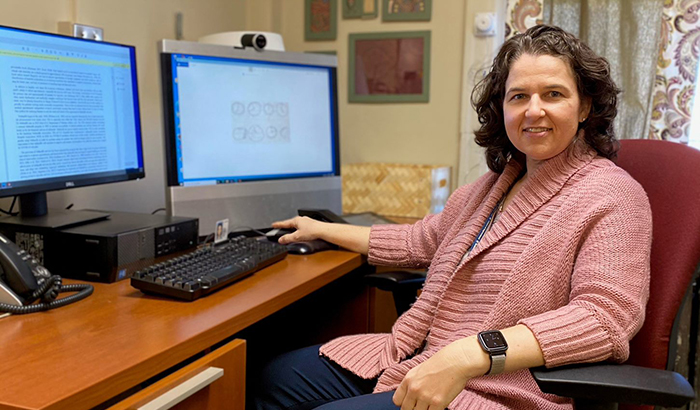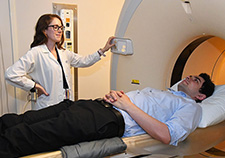Office of Research & Development |
 |
Office of Research & Development |
 |


Dr. Malissa Kraft, a neuropsychologist at VA Bedford, led a study that described teleneuropsychology as a “feasible and acceptable alternative” to traditional in-person cognitive evaluations of older adults.
April 9, 2021
By Mike Richman
VA Research Communications
"VA has been investing in telehealth for years, so the necessary equipment and infrastructure was there. It just seemed like it was meant to be."
Dr. Malissa Kraft, a neuropsychologist at the VA Bedford Healthcare System in Massachusetts, recalls a personal story that made her research hit home.
Born and raised in rural Iowa, she learned firsthand that many specialty health services are not accessible to people who live far from a metropolitan area. When her grandmother had a stroke in 2015, no neurologist or neuropsychologist was close enough to evaluate her, and it wasn’t feasible to drive 100 miles each way for an appointment.
“Asking our elderly, anxious, and possibly cognitively impaired patients to endure a long car ride, in addition to what is already a long and sometimes stressful appointment, just doesn’t seem like a good idea,” Kraft says.

Could cholesterol medicine reduce dementia risk in seniors?

VA study reveals dementia risks unique to people with African ancestry

Head trauma, PTSD may increase genetic variant's impact on Alzheimer's risk

VA-led research finds PET scans important for ruling out Alzheimer's disease
“In addition, caregivers of these older adults are often called upon to provide transportation to appointments. This is a group of adults already facing tremendous stress providing care. Expecting them to take full days off to transport their elderly loved one creates an unnecessary burden and financial repercussions for these caregivers. Even for people who do live near a metropolitan center, the wait times to see a neuropsychologist can be many months.”
When Kraft joined VA Bedford in 2015, she learned that one of her colleagues, Dr. Lauren Moo, had set up a video-to-home teleneurology clinic to manage dementia. Moo co-authored a study on the program in 2020.
Given that Moo had established precedent for providing telehealth services to older Veterans, Kraft felt that creating a teleneuropsychology service to administer cognitive tests over a video call was the next logical step. In a teleneurology dementia visit, she envisioned, a neurologist would talk to a patient, and usually the family caregiver as well, about dementia symptoms and would possibly prescribe medication.
“VA has been investing in telehealth for years, so the necessary equipment and infrastructure was there,” Kraft says. “It just seemed like it was meant to be. The need was there, the resources and support were there, and the motivation was there.”
Kraft has since led a study on patient satisfaction with a teleneuropsychology clinic that VA Bedford opened in 2017 to serve older Veterans with cognitive aging concerns, mainly those related to Alzheimer’s disease, the most common form of dementia. The study appeared in January 2021 in the journal The Clinical Neuropsychologist.
Symptoms of Alzheimer’s include deficits in thoughts, memory, and language. Alzheimer's is the sixth leading cause of mortality in the United States, with death usually a result of complications such as pneumonia and bladder infections.
The clinic is limited to patients age 55 and older. Although most of the evaluations are related to assessing for the presence of dementia, the clinic is not specific to dementia. “We endeavor to assess older adults who are experiencing problems with memory or thinking,” Kraft says, “and while the cause of those problems often ends up being dementia, there are many other potential causes for such problems, as well.”
Her study included 131 Veterans who were enrolled pre-COVID and divided evenly between tele-users of VA Bedford’s teleneuropsychology clinic and those who made in-person visits to that facility. For the former, neuropsychology clinicians at VA Bedford were connected via a video hookup to patients who chose from five CBOCs (community-based outpatient clinics) affiliated with the Manchester VA Medical Center in New Hampshire.
Kraft and her team gave patients a series of cognitive tests resembling those in in-person evaluations. The patients were asked to remember words and stories that are read to them, repeat numbers, and draw objects, such as a clock. They were also asked to think of names of pictures they were shown or think of words starting with a particular letter. The researchers also asked the patients 15 yes-or-no questions to screen for depression, such as:
Trained clinical technicians were on site to help the patients carry out the tasks.
Patient satisfaction was evaluated via a self-report questionnaire. Unsurprising to the researchers, the findings showed that satisfaction was high for all aspects of the patient experience, with no major difference between the groups. Ninety percent of the patients who used the clinics, and 98% of the in-person group, agreed or strongly agreed with the statement, “I was overall satisfied with this visit.” Plus, nearly 87% of patients in the telehealth group, and 84% of the those in the in-person group agreed or strongly agreed with the statement, “Travel to this visit was easy and stress-free.”
“Teleneuropsychology is a feasible and acceptable alternative to traditional in-person neuropsychological evaluations in clinical practice focused on older adults,” Kraft and her team wrote. “Future research should continue to validate evaluation measures used in telehealth settings, identify the populations that would benefit most from teleneurospsychology services, and explore the expansion of teleneuropsychology services.”
Kraft’s research comes as the older adult population in rural areas is growing fast. In fact, more than half of the rural Veterans enrolled in VA services are age 65 or older. The lack of accessibility to health care and specialty services is a problem for this population, which has a greater burden of chronic conditions and a greater chance of dying a preventable death, according to research.
With limited access to specialized experts in cognitive aging, people with dementia are underdiagnosed in about 40% of primary care settings. In addition to lengthy wait times for in-person evaluations, distance and travel time can interfere with an older adult’s ability to attend appointments, especially in rural areas. On average, rural patients travel 30 minutes for primary care and about 90 minutes for specialty care. Older adults with cognitive decline, motor dysfunction, and medically complex conditions that increase their risk for falls and car accidents may place themselves in danger if forced to drive to an evaluation.
In the study, the two groups did not differ in age, level of education, or gender make-up. However, a special formula showed the telehealth group was at a much greater socioeconomic disadvantage.
“We wanted to incorporate this formula as further support that we were targeting in our teleneuropsychology clinic the types of patients and families we expected to be targeting–those that were relatively disadvantaged and had more barriers to traveling long distances to a major hospital, relative to our in-person patients,” Kraft says. “The formula helped to confirm that through our teleneuropsychology clinic we were able to provide services to those Veterans in disadvantaged areas that may be most likely to fall through the cracks, especially when specialty care was needed.”
The average reported travel time for those examined at the clinic was 28 minutes, compared to 38 minutes for the in-person group. The difference may have been related to increased traffic density. Plus, the average distance from the patient’s home to the site where the neuropsychologist is located—the place where they otherwise would have traveled to if the telehealth option wasn’t available—was more than three times the distance to the telehealth appointment.
As of January 2021, about 240 patients had been seen through the clinic at VA Bedford. That figure, Kraft notes, would be much larger when adding in those who have received clinic-to-home evaluations since COVID-19 began. Most of the evaluations in the past year have been clinic-to-home, she says.
When asked if a patient can get the same quality examination in a telehealth clinic as in-person, Kraft differentiates between her clinic’s services that existed before the COVID-19 pandemic and those that have since been provided. Prior to COVID, she says, she was doing clinic-to-clinic evaluations, with a clinician located at a VA facility and the patient at a VA clinic in a neighboring state. However, her clinic pivoted when the pandemic began and started doing clinic-to-home or home-to-home evaluations, with the examiner located at a VA facility or at home and the patient at home.
That switch complicated matters.
“A patient can generally get the same quality examination in a teleneuropsychology clinic that does clinic-to-clinic evaluations that they would get when evaluated by a clinician in-person,” she explains. “However, challenges exist when a teleneuropsychological evaluation is done to the patient’s home that simply don’t exist when the patient is at the clinic. Weak or non-existent internet connections, background noise and distractions, and the inability to watch the patient perform paper-based tasks that involve writing or drawing can negatively impact the quality of the evaluation to the home.
“These issues are essentially non-existent in a clinic-to-clinic evaluation,” she adds. “With the latter, we get all of the information and data we would get if we were to see the patient in-person here at VA Bedford. But the patient would not have the inconvenience of driving a long distance to get here.”
In Kraft’s view, the fact that the clinician is not physically on site with the patient does not present many limitations.
“It’s important to remember a telehealth clinical technician [TCT] is on site with the patient,” Kraft says. “TCTs are staff who are specifically trained to assist with telehealth visits. We provided some additional neuropsychology-specific training to the TCTs so they could be better prepared for teleneuropsychology appointments. While the TCTs don’t administer tests, they serve as a valuable resource for us. They allow us to administer tests that involve showing stimulus materials or doing tasks that involve paper and pencil. Additionally, they serve as our eyes and ears and sometimes nose. They convey helpful information to us about things that may have not been apparent from seeing the patients in the exam room.”
VA Bedford, Kraft says, is one of only a few VA medical centers that use the teleneuropsychology clinic-to-clinic model. A small number of VA sites use the clinic-to-home model, but she believes clinic-to-clinic is better because no TCT is on-site with the patient at home and because of possible internet connection problems. The patients who lack a computer or internet service at home are often those most in need of specialty services. Some VA facilities, Kraft adds, have built neuropsychology into a larger geriatric telehealth clinic where Veterans have one appointment and meet with specialists in geriatric medicine, pharmacy, social work, and neuropsychology, among other disciplines.
Kraft notes that future research on teleneuropsychology clinics should examine concerns specific to “test validity and integrity.”
“This is a large question, and one that has started to receive a lot more attention since the pandemic began,” she explains. “For those who have doubts about teleneuropsychology, I think a lot of the concern is whether administering a test virtually changes the test itself in some way. That is, would the test yield the same exact outcome if it were administered in person versus virtually? It’s a valid question, and one that should be studied more.
“To do so,” she adds, “it would be helpful to have studies that directly compare the underlying cognitive constructs measured by tests administered in-person versus virtually in a teleneuropsychology clinic to establish more certainty about whether tests produce similar results. A few VA and non-VA labs were studying this topic before the pandemic. I suspect that number will grow significantly in the coming months and years.”
VA Research Currents archives || Sign up for VA Research updates